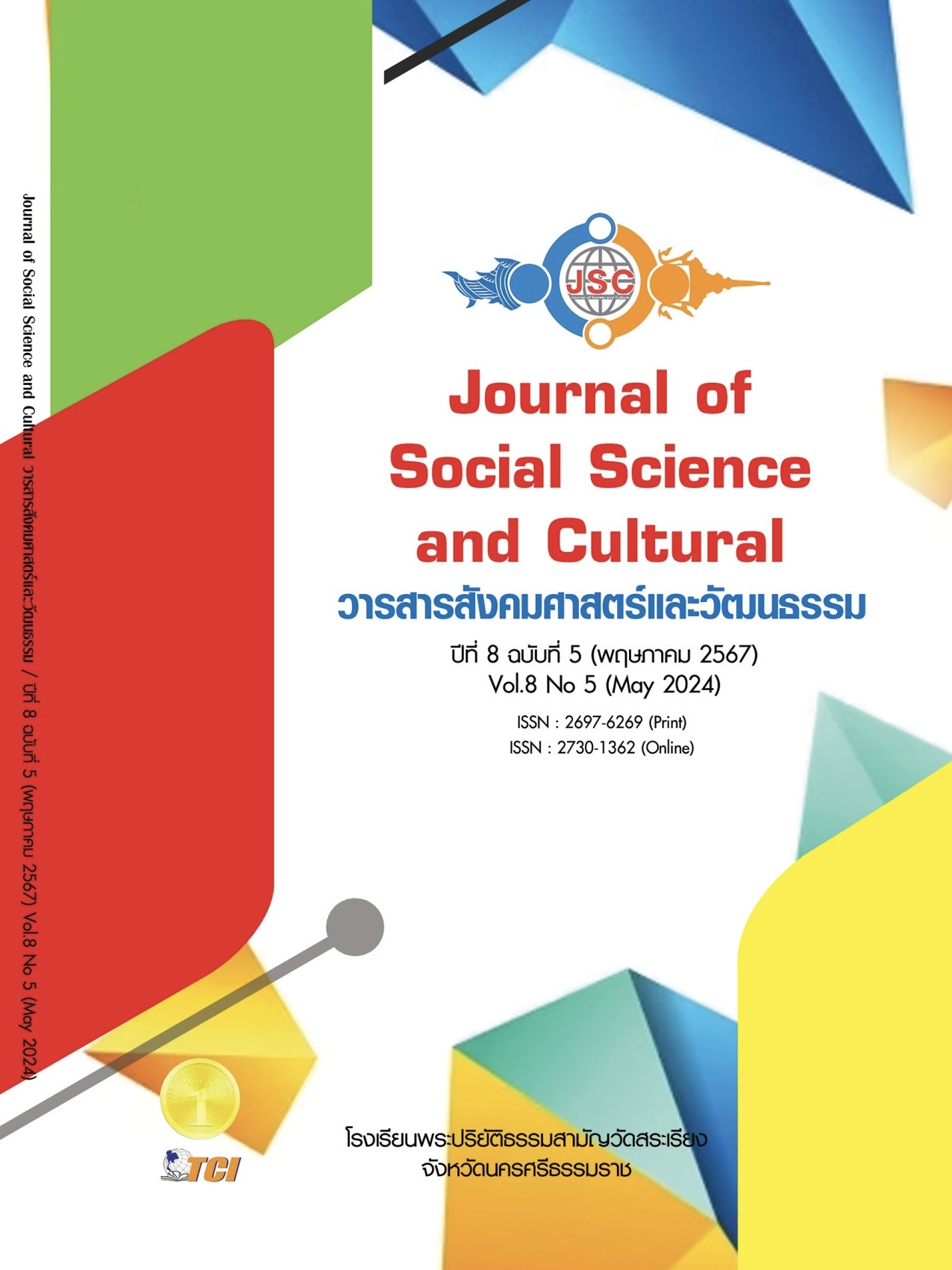CULTURAL CAPITAL AND THE TRANSFORMATION OF THE COMMUNITY THROUGH THE AGES: A CASE STUDY OF WAT THA KHANUN MORAL COMMUNITY, THONG PHAPHUM SUBDISTRICT, THONG PHAPHUM DISTRICT, KANCHANABURI PROVINCE
Main Article Content
Abstract
The objectives of this research were 1) to synthesize the cultural capital of Tha Khanun Community, and 2) to identify the characteristics of the inherited cultural capital of Tha Khanun Community, Thong Pha Phum Subdistrict, Kanchanaburi Province, through the ages using applied historical research method. This qualitative research used a purposive sampling method to select a sample group. The key informants were 1) community leaders, 2) community member representatives, and 3) government organizations. The research instruments used were semi-structured in-depth interviews, participant observations and non-participant observations, and focus group discussions. The data were analyzed using content analysis and an overall summary. The study found that Wat Tha Khanun Moral Community consists of 3 communities: 1) Phatthana Thong Phaphum Community, 2) Rim Fang Khuae Noi Community, and 3) Wang Tha Khanun Community, with Wat Tha Khanun as the center of the communities. Evidence was found that this community has existed since historical times. The cultural capital in this community comprises 1) embodied cultural capital, 2) objectified cultural capital, and 3) institutionalized cultural capital. The Tha Khanun communities have utilized cultural capital to create economic and social value with natural resources and the environment in the communities. All these components of cultural capital are changing in the direction of focusing on using value to drive the community into the future. The inherited cultural capital of the community has changed with the community’s socioeconomic and political context. This has resulted in changes in some parts of the cultural capital in the context of the new generation. However, the world views and cultural paradigms of the older generations still preserve Tha Khanun community’s outstanding self-identities remarkably and remain as cultural capital that forms the foundation that enhances the value, power, and happiness of the evolving Tha Khanun Moral Community.
Article Details
References
ธราดล หีตอักษร. (2566). การสร้างภาคีเครือข่ายการเรียนรู้ตลอดชีวิต: กรณีศึกษาสร้างเครือข่ายการทำน้ำมันเหลืองสมุนไพร. วารสารวิชาการมหาวิทยาลัยการจัดการและเทคโนโลยีอีสเทิร์น, 20(2), 69-78.
นพพร บุญแก้ว และคณะ. (2564). บทบาทของวัฒนธรรมกับการส่งเสริมเศรษฐกิจสร้างสรรค์ของประเทศไทย. วารสารรัฏฐาภิรักษ์, 63(3), 108-121.
นพรัตน์ ไชยชนะ. (2566). แนวทางการสร้างความมั่นคงทางอาหารชุมชนชาติพันธุ์ขมุบ้านบนเขาแก่งเรียง ตำบลท่ากระดาน อำเภอศรีสวัสดิ์ จังหวัดกาญจนบุรี โดยยุทธศาสตร์ BCG. วารสารอินทนิลทักษิณสาร (INTHANINTHAKSIN JOURNAL), 18(1), 111-144.
พชรษณา สุวรรณกลาง. (2565). มายาคติวัฒนธรรมทางความเชื่อ พิธีกรรม: การเปลี่ยนผ่านสู่ยุคดิจิทัล. วารสารพุทธจิตวิทยา, 7(2), 89-98.
พระอำพล ธนปาโล และคณะ. (2565). การจัดการทุนวัฒนธรรมตำนานปราสาทยายเหงา บ้านพูนทราย ตำบลบ้านชบ อำเภอสังขะ จังหวัดสุรินทร์. วารสารศิลปะและวัฒนธรรมลุ่มแม่น้ำมูล, 11(1), 66-77.
เยาวลักษณ์ ตระกูลเมฆี และวิมล งามยิ่งยวด. (2566). แนวทางการจัดการทุนวัฒนธรรมเพื่อฟื้นฟูการปลูกพืชใบพลูในชุมชนต้นแบบ จังหวัดสงขลา. วารสารสังคมและวัฒนธรรม, 7(6), 62-72.
วราภรณ์ เรืองศรี. (2566). อุบลวัณณา: ผู้หญิงในประวัติศาสตร์เปลี่ยนผ่านของยุคสมัย. วารสารประวัติศาสตร์ธรรมศาสตร์, 10(2), 1-34.
สุวิไล เปรมศรีรัตน์. (2544). แผนที่ภาษาศาสตร์เชิงสังคม. กรุงเทพมหานคร: โรงพิมพ์คุรุสภาลาดพร้าว.
เอี่ยม ทองดี. (2548). การเปลี่ยนแปลงทางวัฒนธรรม. วารสารวัฒนธรรมปริทรรศน์, 1(2), 32-46.
Bourdieu, R. (1977). Out of a Theory of Practice. Cambridge: Cambridge University Press.
Chaichana, N. (2018). Modes of Production and Food Security in Cultural Dimensions Ban Thiphuye, Thailand. Asian Political Science Review, 2(2), 24-32.


